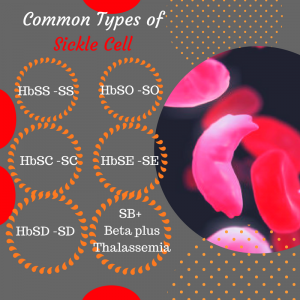Here is Why Warriors or Sicklers are Different!
 There are several types of sickle cell disease. The most common are Sickle Cell Anemia (SS), Sickle Hemoglobin-C Disease (SC), Sickle Beta-Plus Thalassemia and Sickle Beta-Zero Thalassemia.
There are several types of sickle cell disease. The most common are Sickle Cell Anemia (SS), Sickle Hemoglobin-C Disease (SC), Sickle Beta-Plus Thalassemia and Sickle Beta-Zero Thalassemia.
• Sickle Cell Anemia (SS): When a child inherits one substitution beta globin genes (the sickle cell gene) from each parent, the child has Sickle Cell Anemia (SS). Populations that have a high frequency of sickle cell anemia are those of African and Indian descents.
• Sickle Hemoglobin- C Disease (SC): Individuals with Sickle Hemoglobin-C Disease (SC) have a slightly different substitution in their beta globin genes that produces both hemoglobin C and hemoglobin S. Sickle Hemoglobin-C disease may cause similar symptoms as sickle cell anemia but less anemia due to a higher blood count level. Populations that have a high frequency of Sickle Hemoglobin-C disease are those of West African, Mediterranean and Middle Eastern descents.
• Sickle Beta-Plus Thalassemia: Individuals with Sickle Beta Thalassemia (SB) disease also contain substitutions in both beta globin genes. The severity of the disease varies according to the amount of normal beta globin produced. When no beta globin is produced, the symptoms are almost identical to sickle cell anemia, with severe cases needing chronic blood transfusions. Populations that have a high frequency of Sickle Beta Thalassemia are those of Mediterranean and Caribbean descents.
• Sickle Hemoglobin-D Disease: Through research, hemoglobin D, which is a different substitution of the beta-globin gene, has been found to interact with the sickle hemoglobin gene. Individuals with Sickle Hemoglobin-D disease (SD) have moderately severe anemia and occasional pain episodes. Populations that have a high frequency of Sickle Hemoglobin-D disease are those of Asian and Latin American descents.
• Sickle Hemoglobin-O Disease: Hemoglobin O, another type of substitution in the beta globin gene, also interacts with sickle hemoglobin. Individuals with Sickle Hemoglobin- O disease (SO) can have symptoms of sickle cell anemia. Populations that have a high frequency of Sickle Hemoglobin-O disease are those of Arabian, North African and Eastern Mediterranean descents.
“What then is the difference between Sickle Cell SS and Sickle Cell SC?”
Sickle Cell SS and Sickle Cell SC are two different conditions that relate to abnormal protein mutations in blood cells. For one to know if you have either of these conditions and how to treat it, it is important for you to see your doctor and run a test. As stated above, these two conditions are caused by a mutation in the blood cell protein called hemoglobin. There are two genes for this protein (you inherit one from each parent), which is why there are two letters associated with this condition.
If one of these genes is mutated to the “sickle” form, denoted ‘S,’ but the other gene is normal, the person with these genes are said to have sickle cell trait and generally experiences no medical issues and even has a slight resistance to malaria. However, if both genes are mutated to the sickle form, denoted SS, then this is called sickle cell anemia or sickle cell disease, and his or her blood cells can clump together, causing a blockage of blood flow, putting this person at risk for pain crises, bone degeneration, and priapism (prolonged, painful erections).
SC variant is when one gene is mutated to the S form (as mentioned above) and the other is mutated to the C variant, which is also abnormal. Again, people with just one hemoglobin C mutation do not experience any medical issues from it. Even if both hemoglobin genes are mutated to the C form, only mild anemia results. For people with one S and one C mutation, called sickle cell-hemoglobin C, they have fewer episodes of their blood cells clumping together than do people with SS, so they have less pain or crisis, they also have more significant degeneration of bone, retinopathy (degradation of the retina), and increased risk of experiencing priapism.
Again, visit your doctor if you suspect that you have either of these conditions, in order to be appropriately tested for them and treated if necessary.




Recent Comments